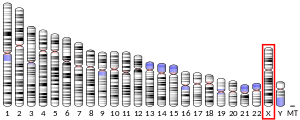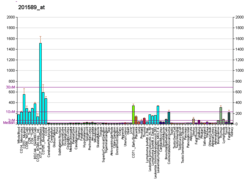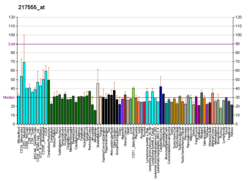SMC1A
Structural maintenance of chromosomes protein 1A (SMC1A) is a protein that in humans is encoded by the SMC1A gene.[5][6] SMC1A is a subunit of the cohesin complex which mediates sister chromatid cohesion, homologous recombination and DNA looping. In somatic cells, cohesin is formed of SMC1A, SMC3, RAD21 and either SA1 or SA2 whereas in meiosis, cohesin is formed of SMC3, SMC1B, REC8 and SA3.
SMC1A is a member of the SMC protein family. Members of this family are key regulators of DNA repair, chromosome condensation and chromosome segregation from bacteria to humans. [7]
Structure
_and_SMC1_(green)_(PDB_2WD5)_from_mice_(Kurze_et_al._2009).png)
_and_RAD21_(green)_(PDB_1W1W)_from_budding_yeast_(Haering_et_al._2004).png)
The domain organisation of SMC proteins is highly conserved and is composed of an N-terminal Walker A motif, coiled-coil, "hinge", coiled-coil and a C-terminal Walker B motif. The protein folds back on itself to form a rod-shaped molecule with a heterodimerisation "hinge" domain at one end and an ABC-type ATPase "head" at the other. These globular domains are separated by a ~50 nm anti-parallel coiled-coil. SMC3 and SMC1 bind via their hinge domains creating V-shaped heterodimers. The N-terminal domain of RAD21 binds to the coiled coil of SMC3 just above the head domain while the C-terminal domain of RAD21 binds the head domain of SMC1. This end to end binding of the SMC3-SMC1-RAD21 trimer creates a closed ring within which DNA can be entrapped.
Function
In addition to entrapping DNA to ensure proper chromosome segregation during the cell cycle, SMC1A, as a component of cohesin, contributes to facilitating inter-chromatid contacts mediating distant-element interactions and to creating chromosome domains called topologically associating domains (TADs). It has been proposed that cohesin promotes the interaction between enhancers and promoters for regulating gene transcription regulation.[8][9][10][11][12][13] The removal of cohesin triggers abnormal TAD topology because loops spanning multiple compartment intervals lead to mixing among loci in different compartments[14][15] As a consequence, loop loss causes gene expression dysregulation.[14] SMC1A also plays a role in spindle pole formation. In fact, in association with SMC3, it is recruited to mitotic spindle poles through interaction with RAE1. The dysregulation of SMC1A (both down- and up-regulation) causes aberrant multi-polar spindles, suggesting that cohesin would function to hold microtubules at the spindle pole.[16][17] Proper cohesion of sister chromatids is a prerequisite for the correct segregation of chromosomes during cell division. The cohesin multiprotein complex is required for sister chromatid cohesion. This complex is composed partly of two structural maintenance of chromosomes (SMC) proteins, SMC3 and either SMC1L2 or the protein encoded by this gene. Most of the cohesin complexes dissociate from the chromosomes before mitosis, although those complexes at the kinetochore remain. Therefore, the encoded protein is thought to be an important part of functional kinetochores. In addition, this protein interacts with BRCA1 and is phosphorylated by ATM, indicating a potential role for this protein in DNA repair. This gene, which belongs to the SMC gene family, is located in an area of the X-chromosome that escapes X inactivation.[6]
Clinical significance
Cornelia de Lange syndrome
Cornelia de Lange syndrome (CdLS) is a rare genetic disorder that presents with variable clinical abnormalities including dysmorphic features, severe growth retardation, global developmental delay, and intellectual disability. The frequency varies from 1:10 000 to 1:30 000 live births without differences between ethnic groups.[18] SMC1A is one of five genes that have been implicated in CdLS. Pathogenic variants in SMC1A, missense and small in frame deletions, are associated with CdLS. SMC1A variants, which maintain the frame of their encoded proteins, are associated with milder CdLS phenotypes with moderate neurocognitive disability and a paucity of major structural defects. The phenotype of SMC1A affected males is more severe than that of mutated females.[19][20][21] Since SMC1A escapes X inactivation, it has been hypothesized that the mechanism in affected females is the dominant-negative effect of the mutated protein.
Genome instability and cancer
SMC1A also takes part in DNA repair. The down-regulation of SMC1A causes genome instability, and CdLS cells carrying SMC1A variants display high level of chromosome aberrations.[22][23][24] Furthermore, SMC1A is phosphorylated on Ser957 and Ser966 residues by ATM and ATR threonine/serine kinases following DNA damage induced by chemical treatment or ionizing radiation. It has been hypothesized that the Breast cancer type 1 susceptibility (BRCA1) gene collaborates in phosphorylating SMC1A, which is required for activation of the S-phase checkpoint allowing blocking of the cell cycle and the repair of DNA.[25][26][23] SMC1A variants have been identified in blood, brain, bladder, and colon cancer.[27][28][29][30][31][32][33] SMC1A plays a pivotal role in colorectal tumorigenesis. Indeed, colorectal tissue acquires extra-copies of SMC1A during cancer development and its expression is significantly stronger in carcinomas than in normal mucosa and early adenoma.[33] Finally, the up-regulation of SMC1A is thought to be a predictor of poor prognosis in colorectal cancer.[34]
References
- GRCh38: Ensembl release 89: ENSG00000072501 - Ensembl, May 2017
- GRCm38: Ensembl release 89: ENSMUSG00000041133 - Ensembl, May 2017
- "Human PubMed Reference:". National Center for Biotechnology Information, U.S. National Library of Medicine.
- "Mouse PubMed Reference:". National Center for Biotechnology Information, U.S. National Library of Medicine.
- Rocques PJ, Clark J, Ball S, Crew J, Gill S, Christodoulou Z, et al. (February 1995). "The human SB1.8 gene (DXS423E) encodes a putative chromosome segregation protein conserved in lower eukaryotes and prokaryotes". Human Molecular Genetics. 4 (2): 243–9. doi:10.1093/hmg/4.2.243. PMID 7757074.
- "Entrez Gene: SMC1A structural maintenance of chromosomes 1A".
- Yatskevich S, Rhodes J, Nasmyth K (December 2019). "Organization of Chromosomal DNA by SMC Complexes". Annual Review of Genetics. 53: 445–482. doi:10.1146/annurev-genet-112618-043633. PMID 31577909.
- Wendt KS, Yoshida K, Itoh T, Bando M, Koch B, Schirghuber E, et al. (February 2008). "Cohesin mediates transcriptional insulation by CCCTC-binding factor". Nature. 451 (7180): 796–801. Bibcode:2008Natur.451..796W. doi:10.1038/nature06634. PMID 18235444.
- Hadjur S, Williams LM, Ryan NK, Cobb BS, Sexton T, Fraser P, et al. (July 2009). "Cohesins form chromosomal cis-interactions at the developmentally regulated IFNG locus". Nature. 460 (7253): 410–3. Bibcode:2009Natur.460..410H. doi:10.1038/nature08079. PMC 2869028. PMID 19458616.
- Dixon JR, Selvaraj S, Yue F, Kim A, Li Y, Shen Y, et al. (April 2012). "Topological domains in mammalian genomes identified by analysis of chromatin interactions". Nature. 485 (7398): 376–80. Bibcode:2012Natur.485..376D. doi:10.1038/nature11082. PMC 3356448. PMID 22495300.
- Nora EP, Lajoie BR, Schulz EG, Giorgetti L, Okamoto I, Servant N, et al. (April 2012). "Spatial partitioning of the regulatory landscape of the X-inactivation centre". Nature. 485 (7398): 381–5. Bibcode:2012Natur.485..381N. doi:10.1038/nature11049. PMC 3555144. PMID 22495304.
- Seitan VC, Faure AJ, Zhan Y, McCord RP, Lajoie BR, Ing-Simmons E, et al. (December 2013). "Cohesin-based chromatin interactions enable regulated gene expression within preexisting architectural compartments". Genome Research. 23 (12): 2066–77. doi:10.1101/gr.161620.113. PMC 3847776. PMID 24002784.
- Sofueva S, Yaffe E, Chan WC, Georgopoulou D, Vietri Rudan M, Mira-Bontenbal H, et al. (December 2013). "Cohesin-mediated interactions organize chromosomal domain architecture". The EMBO Journal. 32 (24): 3119–29. doi:10.1038/emboj.2013.237. PMC 4489921. PMID 24185899.
- Rao SS, Huang SC, Glenn St Hilaire B, Engreitz JM, Perez EM, Kieffer-Kwon KR, et al. (October 2017). "Cohesin Loss Eliminates All Loop Domains". Cell. 171 (2): 305–320.e24. doi:10.1016/j.cell.2017.09.026. PMC 5846482. PMID 28985562.
- Schwarzer W, Abdennur N, Goloborodko A, Pekowska A, Fudenberg G, Loe-Mie Y, et al. (November 2017). "Two independent modes of chromatin organization revealed by cohesin removal". Nature. 551 (7678): 51–56. Bibcode:2017Natur.551...51S. doi:10.1038/nature24281. PMC 5687303. PMID 29094699.
- Wong RW (January 2010). "Interaction between Rae1 and cohesin subunit SMC1 is required for proper spindle formation". Cell Cycle. 9 (1): 198–200. doi:10.4161/cc.9.1.10431. PMID 20016259.
- Wong RW (May 2010). "An update on cohesin function as a 'molecular glue' on chromosomes and spindles". Cell Cycle. 9 (9): 1754–8. doi:10.4161/cc.9.9.11806. PMID 20436296.
- Ramos FJ, Puisac B, Baquero-Montoya C, Gil-Rodríguez MC, Bueno I, Deardorff MA, et al. (October 2015). "Clinical utility gene card for: Cornelia de Lange syndrome". European Journal of Human Genetics. 23 (10): 1431. doi:10.1038/ejhg.2014.270. PMC 4592075. PMID 25537356.
- Musio A, Selicorni A, Focarelli ML, Gervasini C, Milani D, Russo S, et al. (May 2006). "X-linked Cornelia de Lange syndrome owing to SMC1L1 mutations". Nature Genetics. 38 (5): 528–30. doi:10.1038/ng1779. PMID 16604071.
- Borck G, Zarhrate M, Bonnefont JP, Munnich A, Cormier-Daire V, Colleaux L (February 2007). "Incidence and clinical features of X-linked Cornelia de Lange syndrome due to SMC1L1 mutations". Human Mutation. 28 (2): 205–6. doi:10.1002/humu.9478. PMID 17221863.
- Deardorff MA, Kaur M, Yaeger D, Rampuria A, Korolev S, Pie J, et al. (March 2007). "Mutations in cohesin complex members SMC3 and SMC1A cause a mild variant of cornelia de Lange syndrome with predominant mental retardation". American Journal of Human Genetics. 80 (3): 485–94. doi:10.1086/511888. PMC 1821101. PMID 17273969.
- Musio A, Montagna C, Zambroni D, Indino E, Barbieri O, Citti L, et al. (June 2003). "Inhibition of BUB1 results in genomic instability and anchorage-independent growth of normal human fibroblasts". Cancer Research. 63 (11): 2855–63. PMID 12782591.
- Musio A, Montagna C, Mariani T, Tilenni M, Focarelli ML, Brait L, et al. (February 2005). "SMC1 involvement in fragile site expression". Human Molecular Genetics. 14 (4): 525–33. doi:10.1093/hmg/ddi049. PMID 15640246.
- Cukrov D, Newman TA, Leask M, Leeke B, Sarogni P, Patimo A, et al. (September 2018). "Antioxidant treatment ameliorates phenotypic features of SMC1A-mutated Cornelia de Lange syndrome in vitro and in vivo". Human Molecular Genetics. 27 (17): 3002–3011. doi:10.1093/hmg/ddy203. PMID 29860495.
- Kim ST, Xu B, Kastan MB (March 2002). "Involvement of the cohesin protein, Smc1, in Atm-dependent and independent responses to DNA damage". Genes & Development. 16 (5): 560–70. doi:10.1101/gad.970602. PMC 155347. PMID 11877376.
- Yazdi PT, Wang Y, Zhao S, Patel N, Lee EY, Qin J (March 2002). "SMC1 is a downstream effector in the ATM/NBS1 branch of the human S-phase checkpoint". Genes & Development. 16 (5): 571–82. doi:10.1101/gad.970702. PMC 155356. PMID 11877377.
- Balbás-Martínez C, Sagrera A, Carrillo-de-Santa-Pau E, Earl J, Márquez M, Vazquez M, et al. (December 2013). "Recurrent inactivation of STAG2 in bladder cancer is not associated with aneuploidy". Nature Genetics. 45 (12): 1464–9. doi:10.1038/ng.2799. PMC 3840052. PMID 24121791.
- Ley TJ, Miller C, Ding L, Raphael BJ, Mungall AJ, Robertson A, et al. (May 2013). "Genomic and epigenomic landscapes of adult de novo acute myeloid leukemia". The New England Journal of Medicine. 368 (22): 2059–74. doi:10.1056/NEJMoa1301689. PMC 3767041. PMID 23634996.
- Cucco F, Servadio A, Gatti V, Bianchi P, Mannini L, Prodosmo A, et al. (December 2014). "Mutant cohesin drives chromosomal instability in early colorectal adenomas". Human Molecular Genetics. 23 (25): 6773–8. doi:10.1093/hmg/ddu394. PMID 25080505.
- Huether R, Dong L, Chen X, Wu G, Parker M, Wei L, et al. (April 2014). "The landscape of somatic mutations in epigenetic regulators across 1,000 paediatric cancer genomes". Nature Communications. 5: 3630. Bibcode:2014NatCo...5.3630H. doi:10.1038/ncomms4630. PMC 4119022. PMID 24710217.
- Thol F, Bollin R, Gehlhaar M, Walter C, Dugas M, Suchanek KJ, et al. (February 2014). "Mutations in the cohesin complex in acute myeloid leukemia: clinical and prognostic implications". Blood. 123 (6): 914–20. doi:10.1182/blood-2013-07-518746. PMID 24335498.
- Cessna MH, Paulraj P, Hilton B, Sadre-Bazzaz K, Szankasi P, Cluff A, et al. (October 2019). "Chronic myelomonocytic leukemia with ETV6-ABL1 rearrangement and SMC1A mutation". Cancer Genetics. 238: 31–36. doi:10.1016/j.cancergen.2019.07.004. PMID 31425923.
- Sarogni P, Palumbo O, Servadio A, Astigiano S, D'Alessio B, Gatti V, et al. (March 2019). "Overexpression of the cohesin-core subunit SMC1A contributes to colorectal cancer development". Journal of Experimental & Clinical Cancer Research. 38 (1): 108. doi:10.1186/s13046-019-1116-0. PMC 6397456. PMID 30823889.
- Wang J, Yu S, Cui L, Wang W, Li J, Wang K, Lao X (March 2015). "Role of SMC1A overexpression as a predictor of poor prognosis in late stage colorectal cancer". BMC Cancer. 15: 90. doi:10.1186/s12885-015-1085-4. PMC 4352287. PMID 25884313.





